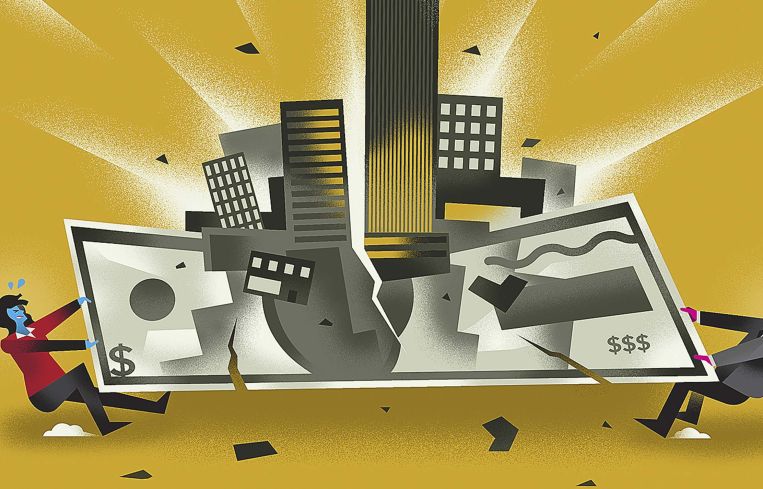CRE Lenders Aid Struggling Borrowers Despite Leverage Advantage
By Andrew Coen May 3, 2021 9:00 am
reprints
There’s a quote attributed to 20th-century industrialist J. Paul Getty: “If you owe the bank $100, that’s your problem. If you owe the bank $100 million, that’s the bank’s problem.”
Never has there been a greater moment to test Getty’s thesis than the last 14 months.
After a few solid years of a borrower’s market, with lenders of all stripes clamoring over deals and sacrificing yield in the pursuit of deploying capital, the power balance swung at the onset of the COVID-19 pandemic and it looked like all the power in deals would be weighted heavily toward lenders. Absent a crystal ball, coronavirus clauses hadn’t been written preemptively into loan documents, raising the question of whether defaults and modifications would be treated differently and with more understanding than during the global financial crisis (GFC).
COVID-19 undoubtedly forced a different dialogue between lender and borrower. Unlike the GFC, this market correction wasn’t borne out of the financial markets. Nobody behaved badly and toppled a financial system. Instead, this was a health crisis that permeated the financial markets and knocked the entire industry — borrower, lender, broker, lawyer — for six.
Given the common denominator of the devastating human element of this unforeseen dislocation, commercial real estate financiers have — for the most part — sought to work collaboratively with borrowers.
That said, it’s safe to say that not all relationships have remained intact.
“There were some sponsors who never asked for anything; they just kept paying and supporting their properties, and did what was right,” said one alternative lender who spoke on the condition of anonymity. “Then, there were other sponsors who immediately didn’t want to pay and acted very differently. And, so, I think if you have the ability to choose who you do business with, something like this COVID crisis shows you who that person is. Obviously, some lenders acted very differently, too. But, for me, as a lender, there are certainly borrowers I never want to deal with again.”
A number of commercial real estate lenders took defensive positions early on in the crisis in order to asset manage their existing portfolios and better position themselves for a rebound once the economy opened back up. While some lenders took hardline stances as borrowers faced increasing hardships during mandated business closures and social distancing restrictions, many lenders pursued ways to manage their clients through the adversity.
“We took a proactive and practical approach to working with borrowers on loan modifications on deals that were adversely impacted by COVID-19,” said Priyanka Garg, co-head of credit business at Mack Real Estate Credit Strategies (MRECS). “In the few cases where that was not possible, we exercised our remedies.”
Garg noted that “communication and creativity” took on a greater importance during the dark times of the pandemic, when borrowers faced many unknowns in terms of how long the economy would be on ice.
While foreclosures and bankruptcies have been unusual across MRECS’ assets, they took action when necessary. The New York City-based firm seized control of a seven-property Manhattan portfolio in March, months after Cindat Capital Management and Hersha Hospitality Trust defaulted on an $85 million mezzanine loan.
MRECS also implemented a Uniform Commercial Code (UCC) foreclosure sale of the Brooklyn mega-housing development, Denizen Bushwick, operated by Yoel Goldman’s All Year Management. Goldman filed a petition for Chapter 11 in late February to try and stop the foreclosure sale.
Stephen Rosenberg, founder and CEO of Greystone, said he noticed more “compassion” in the market about late payments at the beginning of the pandemic, given the unique circumstances of the health crisis. He has sought to continue that mindset one year later.
“Lenders were willing to give people more time and they weren’t as sharp-elbowed as they might otherwise have been,” said Rosenberg, whose firm originated $16.6 billion for calendar year 2020, aided by a large focus on multifamily and health care deals. “Just because you have the hammer doesn’t always mean you have to use it.”
Greystone bought around $20 billion of special servicing from C-III Asset Management, which the firm acquired in late 2019 just prior to the pandemic. Rosenberg said part of the strategy behind the C-III acquisition was to enhance the reputation of commercial real estate special servicing as a black hole when loans go into default.
“I wanted to overturn the concept that these were impossible people to deal with,” said Rosenberg of borrowers who require special servicing. “Sure, we are responsible to our investors and to the bondholders, but that doesn’t mean you have to be mean-
spirited.”
Matthew Rosenfeld, senior vice president and head of U.S. debt at Cain International, stressed that enhanced communication and flexibility during trying economic times is crucial for lenders to be successful long term. Cain, as both a borrower and lender, is always looking for ways to work with counterparties beyond the initial transaction to make sure they grow their platforms, while also lending expertise in markets where it has significant exposure as either an investor or operator.
“You can’t underwrite a pandemic, but you can choose quality partners and build strong, long-lasting relationships,” Rosenfeld said. “That approach has been invaluable in what was, ultimately, a major stress test for lender-borrower relationships.”
As for banks, they’ve been more stringent with lending terms during the pandemic than private lenders, largely because they’re subjected to regulators dictating reserve requirements, said Jeffrey Simpson, managing partner at Arch Companies. He noted that private fund lenders are not regulated, so they aren’t facing the same financial obligations, and CMBS originators have their own unique circumstances since originators aren’t typically involved until post-securitization.
“Firsthand, I have seen bankers be put in positions that they were not used to being put into and it may not be their own choice,” Simpson said of the dynamic of banks pressuring borrowers because of the heat they, themselves, are feeling from regulators. “As loans get written down, that changes the game.”
Arch, which was founded three years ago, had a number of holdings in safer asset classes during COVID, like multifamily properties in the South, which Simpson said helped in avoiding any major lender disputes. While Simpson’s communications with lenders were all positive early on in the pandemic, he acknowledged that this was probably “an anomaly” compared to other borrowers, who were facing far more hard-hit asset classes.
Simpson has noticed in the last year various scenarios with surprising loans put on the market with only limited levels of distress, and other instances of more stressed loans not being sold. He noted that no lender-borrower relationship could repair some loans that were troubled even before COVID, especially in the struggling retail and hotel space, and how the two work together in the year ahead remains in limbo.
“We see a lot of defaulted developments in New York, other markets where lenders just want out badly,” Simpson said. “There is a lot that is still yet to be seen and I think we have to get through the other side of all these deferments and forbearances, and we have to have some return to normalcy and then we will have a recalibration of where we are actually at.”


